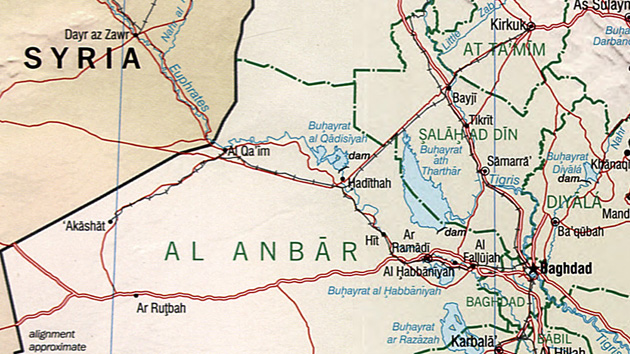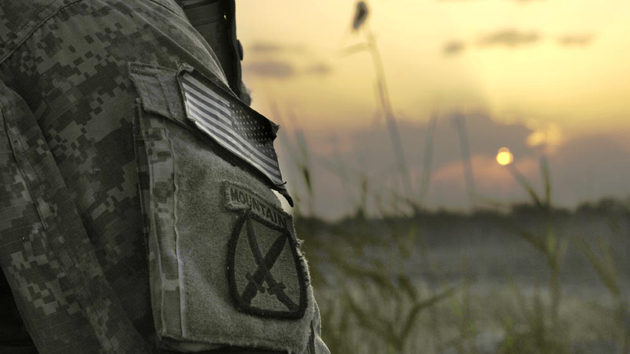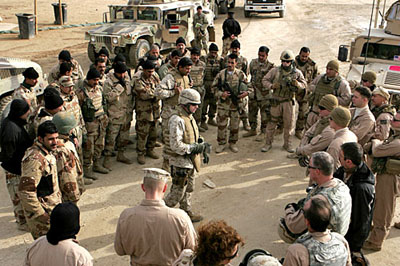
<a href="http://commons.wikimedia.org/wiki/Atlas_of_Iraq">Wikimedia Commons</a>
This story first appeared on the TomDispatch website.
I wanted to offer a wry chuckle before we headed into the heavy stuff about Iraq, so I tried to start this article with a suitably ironic formulation. You know, a déjà-vu-all-over-again kinda thing. I even thought about telling you how, in 2011, I contacted a noted author to blurb my book, We Meant Well: How I Helped Lose the Battle for the Hearts and Minds of the Iraqi People, and he presciently declined, saying sardonically, “So you’re gonna be the one to write the last book on failure in Iraq?”
I couldn’t do any of that. As someone who cares deeply about this country, I find it beyond belief that Washington has again plunged into the swamp of the Sunni-Shia mess in Iraq. A young soldier now deployed as one of the 1,600 non-boots-on-the-ground there might have been eight years old when the 2003 invasion took place. He probably had to ask his dad about it. After all, less than three years ago, when dad finally came home with his head “held high,” President Obama assured Americans that “we’re leaving behind a sovereign, stable and self-reliant Iraq.” So what happened in the blink of an eye?
The Sons of Iraq
Sometimes, when I turn on the TV these days, the sense of seeing once again places in Iraq I’d been overwhelms me. After 22 years as a diplomat with the Department of State, I spent 12 long months in Iraq in 2009-2010 as part of the American occupation. My role was to lead two teams in “reconstructing” the nation. In practice, that meant paying for schools that would never be completed, setting up pastry shops on streets without water or electricity, and conducting endless propaganda events on Washington-generated themes of the week (“small business,” “women’s empowerment,” “democracy building.”)
We even organized awkward soccer matches, where American taxpayer money was used to coerce reluctant Sunni teams into facing off against hesitant Shia ones in hopes that, somehow, the chaos created by the American invasion could be ameliorated on the playing field. In an afternoon, we definitively failed to reconcile the millennium-old Sunni-Shia divide we had sparked into ethnic-cleansing-style life in 2003-2004, even if the score was carefully stage managed into a tie by the 82nd Airborne soldiers with whom I worked.
In 2006, the US brokered the ascension to power of Prime Minister Nouri al-Maliki, a Shia politician handpicked to unite Iraq. A bright, shining lie of a plan soon followed. Applying vast amounts of money, Washington’s emissaries created the Sahwa, or Sons of Iraq, a loose grouping of Sunnis anointed as “moderates” who agreed to temporarily stop killing in return for a promised place at the table in the New(er) Iraq. The “political space” for this was to be created by a massive escalation of the American military effort, which gained a particularly marketable name: the surge.
I was charged with meeting the Sahwa leaders in my area. My job back then was to try to persuade them to stay on board just a little longer, even as they came to realize that they’d been had. Maliki’s Shia government in Baghdad, which was already ignoring American entreaties to be inclusive, was hell-bent on ensuring that there would be no Sunni “sons” in its Iraq.
False alliances and double-crosses were not unfamiliar to the Sunni warlords I engaged with. Often, our talk—over endless tiny glasses of sweet, sweet tea stirred with white-hot metal spoons—shifted from the Shia and the Americans to their great-grandfathers’ struggle against the British. Revenge unfolds over generations, they assured me, and memories are long in the Middle East, they warned.
When I left in 2010, the year before the American military finally departed, the truth on the ground should have been clear enough to anyone with the vision to take it in. Iraq had already been tacitly divided into feuding state-lets controlled by Sunnis, Shias, and Kurds. The Baghdad government had turned into a typical, gleeful third-world kleptocracy fueled by American money, but with a particularly nasty twist: they were also a group of autocrats dedicated to persecuting, marginalizing, degrading, and perhaps one day destroying the country’s Sunni minority.
 US influence was fading fast, leaving the State Department, a small military contingent, various spooks, and contractors hidden behind the walls of the billion-dollar embassy (the largest in the world!) that had been built in a moment of imperial hubris. The foreign power with the most influence over events was by then Iran, the country the Bush administration had once been determined to take down alongside Saddam Hussein as part of the Axis of Evil.
US influence was fading fast, leaving the State Department, a small military contingent, various spooks, and contractors hidden behind the walls of the billion-dollar embassy (the largest in the world!) that had been built in a moment of imperial hubris. The foreign power with the most influence over events was by then Iran, the country the Bush administration had once been determined to take down alongside Saddam Hussein as part of the Axis of Evil.
The Grandsons of Iraq
The staggering costs of all this—$25 billion to train the Iraqi Army, $60 billion for the reconstruction-that-wasn’t, $2 trillion for the overall war, almost 4,500 Americans dead and more than 32,000 wounded, and an Iraqi death toll of more than 190,000 (though some estimates go as high as a million)—can now be measured against the results. The nine-year attempt to create an American client state in Iraq failed, tragically and completely. The proof of that is on today’s front pages.
According to the crudest possible calculation, we spent blood and got no oil. Instead, America’s war of terror resulted in the dissolution of a Middle Eastern post-Cold War stasis that, curiously enough, had been held together by Iraq’s previous autocratic ruler Saddam Hussein. We released a hornet’s nest of Islamic fervor, sectarianism, fundamentalism, and pan-nationalism. Islamic terror groups grew stronger and more diffuse by the year. That horrible lightning over the Middle East that’s left American foreign policy in such an ugly glare will last into our grandchildren’s days. There should have been so many futures. Now, there will be so few as the dead accumulate in the ruins of our hubris. That is all that we won.
Under a new president, elected in 2008 in part on his promise to end American military involvement in Iraq, Washington’s strategy morphed into the more media-palatable mantra of “no boots on the ground.” Instead, backed by aggressive intel and the “surgical” application of drone strikes and other kinds of air power, US covert ops were to link up with the “moderate” elements in Islamic governments or among the rebels opposing them—depending on whether Washington was opting to support a thug government or thug fighters.
The results? Chaos in Libya, highlighted by the flow of advanced weaponry from the arsenals of the dead autocrat Muammar Gaddafi across the Middle East and significant parts of Africa, chaos in Yemen, chaos in Syria, chaos in Somalia, chaos in Kenya, chaos in South Sudan, and, of course, chaos in Iraq.
And then came the Islamic State (IS) and the new “caliphate,” the child born of a neglectful occupation and an autocratic Shia government out to put the Sunnis in their place once and for all. And suddenly we were heading back into Iraq. What, in August 2014, was initially promoted as a limited humanitarian effort to save the Yazidis, a small religious sect that no one in Washington or anywhere else in this country had previously heard of, quickly morphed into those 1,600 American troops back on the ground in Iraq and American planes in the skies from Kurdistan in the north to south of Baghdad. The Yazidis were either abandoned, or saved, or just not needed anymore. Who knows and who, by then, cared? They had, after all, served their purpose handsomely as the casus belli of this war. Their agony at least had a horrific reality, unlike the supposed attack in the Gulf of Tonkin that propelled a widening war in Vietnam in 1964 or the nonexistent Iraqi WMDs that were the excuse for the invasion of 2003.
The newest Iraq war features Special Operations “trainers,” air strikes against IS fighters using American weapons abandoned by the Iraqi Army (now evidently to be resupplied by Washington), US aircraft taking to the skies from inside Iraq as well as a carrier in the Persian Gulf and possibly elsewhere, and an air war across the border into Syria.
It Takes a Lot of Turning Points To Go In a Circle
The truth on the ground these days is tragically familiar: an Iraq even more divided into feuding state-lets; a Baghdad government kleptocracy about to be reinvigorated by free-flowing American money; and a new Shia prime minister being issued the same 2003-2011 to-do list by Washington: mollify the Sunnis, unify Iraq, and make it snappy. The State Department still stays hidden behind the walls of that billion-dollar embassy. More money will be spent to train the collapsed Iraqi military. Iran remains the foreign power with the most influence over events.
One odd difference should be noted, however: in the last Iraq war, the Iranians sponsored and directed attacks by Shia militias against American occupation forces (and me); now, its special operatives and combat advisors fight side-by-side with those same Shia militias under the cover of American air power. You want real boots on the ground? Iranian forces are already there. It’s certainly an example of how politics makes strange bedfellows, but also of what happens when you assemble your “strategy” on the run.
Obama hardly can be blamed for all of this, but he’s done his part to make it worse—and worse it will surely get as his administration once again assumes ownership of the Sunni-Shia fight. The “new” unity plan that will fail follows the pattern of the one that did fail in 2007: use American military force to create a political space for “reconciliation” between once-burned, twice-shy Sunnis and a compromise Shia government that American money tries to nudge into an agreement against Iran’s wishes. Perhaps whatever new Sunni organization is pasted together, however briefly, by American representatives should be called the Grandsons of Iraq.
Just to add to the general eeriness factor, the key people in charge of putting Washington’s plans into effect are distinctly familiar faces. Brett McGurk, who served in key Iraq policy positions throughout the Bush and Obama administrations, is again the point man as Deputy Assistant Secretary of State for Iraq and Iran. McGurk was once called the “Maliki whisperer” for his closeness to the former prime minister. The current American ambassador, Robert Stephen Beecroft, was deputy chief of mission, the number two at the Baghdad embassy, back in 2011. Diplomatically, another faux coalition of the (remarkably un)willing is being assembled. And the pundits demanding war in a feverish hysteria in Washington are all familiar names, mostly leftovers from the glory days of the 2003 invasion.
Lloyd Austin, the general overseeing America’s new military effort, oversaw the 2011 retreat. General John Allen, brought out of military retirement to coordinate the new war in the region—he had recently been a civilian advisor to Secretary of State John Kerry—was deputy commander in Iraq’s Anbar province during the surge. Also on the US side, the mercenary security contractors are back, even as President Obama cites, without a hint of irony, the ancient 2002 congressional authorization to invade Iraq he opposed as candidate Obama as one of his legal justifications for this year’s war. The Iranians, too, have the same military commander on the ground in Iraq, Qassem Suleimani, the head of the Iranian Revolutionary Guards Corps’s Quds Force. Small world. Suleimani also helps direct Hezbollah operations inside Syria.
Even the aircraft carrier in the Persian Gulf launching air strikes, the USS George H.W. Bush, is fittingly named after the president who first got us deep into Iraq almost a quarter century ago. Just consider that for a moment: we have been in Iraq so long that we now have an aircraft carrier named after the president who launched the adventure.
On a 36-month schedule for “destroying” ISIS, the president is already ceding his war to the next president, as was done to him by George W. Bush. That next president may well be Hillary Clinton, who was secretary of state as Iraq War 2.0 sputtered to its conclusion. Notably, it was her husband whose administration kept the original Iraq War of 1990-1991 alive via no-fly zones and sanctions. Call that a pedigree of sorts when it comes to fighting in Iraq until hell freezes over.
If there is a summary lesson here, perhaps it’s that there is evidently no hole that can’t be dug deeper. How could it be more obvious, after more than two decades of empty declarations of victory in Iraq, that genuine “success,” however defined, is impossible? The only way to win is not to play. Otherwise, you’re just a sucker at the geopolitical equivalent of a carnival ringtoss game with a fist full of quarters to trade for a cheap stuffed animal.
Apocalypse Then—And Now
America’s wars in the Middle East exist in a hallucinatory space where reality is of little import, so if you think you heard all this before, between 2003 and 2010, you did. But for those of us of a certain age, the echoes go back much further. I recently joined a discussion on Dutch television where former Republican Congressman Pete Hoekstra made a telling slip of the tongue. As we spoke about ISIS, Hoekstra insisted that the US needed to deny them “sanctuary in Cambodia.” He quickly corrected himself to say “Syria,” but the point was made.
We’ve been here before, as the failures of American policy and strategy in Vietnam metastasized into war in Cambodia and Laos to deny sanctuary to North Vietnamese forces. As with ISIS, we were told that they were barbarians who sought to impose an evil philosophy across an entire region. They, too, famously needed to be fought “over there” to prevent them from attacking us here. We didn’t say “the Homeland” back then, but you get the picture.
As the similarities with Vietnam are telling, so is the difference. When the reality of America’s failure in Vietnam finally became so clear that there was no one left to lie to, America’s war there ended and the troops came home. They never went back. America is now fighting the Iraq War for the third time, somehow madly expecting different results, while guaranteeing only failure. To paraphrase a young John Kerry, himself back from Vietnam, who’ll be the last to die for that endless mistake? It seems as if it will be many years before we know.
Peter Van Buren blew the whistle on State Department waste and mismanagement during the Iraqi reconstruction in his first book, We Meant Well: How I Helped Lose the Battle for the Hearts and Minds of the Iraqi People. A Tom Dispatch regular, he writes about current events at his blog, We Meant Well. His latest book is Ghosts of Tom Joad: A Story of the #99Percent. To stay on top of important articles like these, sign up to receive the latest updates from TomDispatch.com here.














